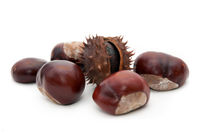Aesculus hippocastanum
| See Also | Botanical Monographs |
|---|
Horse Chestnut (Aesculus hippocastanum) is known for its ability to treat hemorrhoids and varicose veins. To explore the characteristics, medicinal uses and prescribing considerations of this herb in more detail, check out the references indicated.[1], [2]
Contents
Characteristics
- Common Names: Horse Chestnut
- Family: Hippocastanaceae
- Habitat: Aesculus hippocastanum is native from Italy and Greece to Northern India and recently naturalized to North America.
- Parts Used: Bark or out seed coat
- Constituents: triterpene saponins (escin or asecin)
- Medicinal Actions: astringent, expectorant (weak action), antioedematous, tonic
Uses
Historical Uses:
Aesculus hippocastanum was traditionally used for hemorrhoids due to dysentery or diarrhea.
Medicinal Uses:
Internal
- vascular engorgement - leads to dull aching pain, throbbing sensation in veins (not arteries), general feeling of fullness and malaise
- chronic venous insufficiency - varicose veins
- vascular congestion (hemorrhoids) in the rectum - large, purple, don't bleed, sense of fullness in rectum, can also result from dysentery or diarrhea
- vascular wall fragility - leading to edema or exudate, might see swelling in feet or extremeties
- visceral neuralgia
- edema of the urethral mucosa (varicosity of urethra)
- hepatic aching (aching pains over the liver)
External
- hemorrhoids, rectal constipation, puritis anii
- varicose veins, nocturnal leg cramps
Prescribing Considerations
The information provided is intended to augment the treatment from a naturopathic doctor or other trained medical professional. Although most herbs are generally safe, it is recommended that you avoid self-prescribing especially when there is an underlying ongoing medical condition, if you are on any prescription medications or if you are pregnant or breastfeeding.
Formulations and Preparation
- Tincture - up to 20 drops three times daily
- Acute - 5-15 drops in water and take every 1-3 hours
- Fluid extract - up to 20 drops three times daily
- Standardized extract (to aescin (in Europe)) - 30-150mg of aescin daily; A. hippocastanum can also be found in a cream (for topical application) in Europe but is traditionally used orally
- Poultice - more commonly used in conjunction with oral administration, twice daily
- Ointment, gel, or oil - apply morning and evening to varicose veins or hemorrhoids; also useful externally for painful night leg cramps
Safety
The safety and prescribing considerations for this herb include:[3], [4]
- Generally regarded as safe.
- Side-effects of the Horsechestnut seed extract are gastrointestinal upset, calf spasm, headache, nausea, itchy skin. No side effects are reported for the cream or gel.
- Cautions and Contraindications: pregnancy and lactation; kidney and liver disease
- Drug-Herb Interactions.[3]
- Corticosteroids, oral - Potential or theoretical beneficial or supportive interaction with professional management; May provide additive beneficial antioedematous effects especially in cerebral edema.
- Heparin Sodium + Phosphatidylcholine + Aescin - Beneficial or supportive interaction with professional management; The combination synergistically enhances anti-inflammatory, antioedematous, anti-exudative effects of the herb.
References
- ↑ Boon Heather, Smith Michael (2009) 55 Most Common Medicinal Herbs: The Complete Natural Medicine Guide Second Edition Institute of Naturopathic Education and Research, CCNM Toronto.
- ↑ Godfrey Anthony, Saunders Paul, Barlow Kerry, Gowan Matt (2011) Principles and Practices of Naturopathic Botanical Medicine, Advanced Botanical Medicine. V3 CCNM Press, Toronto.
- ↑ 3.0 3.1 Stargrove Mitchell Bebell, Treasure Jonathan, McKee Dwight L (2008) Herb, Nutrient and Drug Interactions: Clinical Implications and Therapeutic Strategies.
- ↑ Brinker Francis (1997) Herbal Contraindications and Drug Interactions: Plus Herbal Adjuncts With Medicines, 4th Edition Eclectic Medical Publications.
